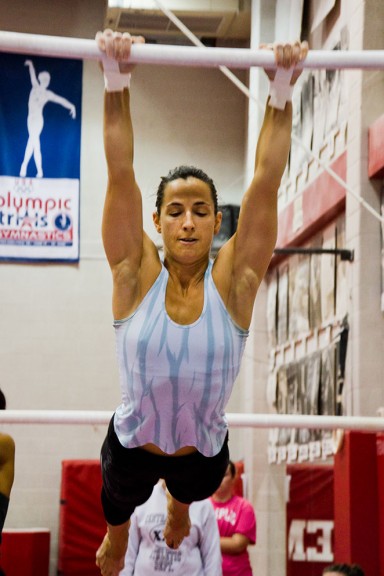
Anetta Dubinchik developed an interest in gymnastics from her family growing up in Tashkent, Uzbekistan. However, a move to the United States posed a geographical obstacle.
“I moved to Holland, Pa., in first grade,” Dubinchik, a senior biology major, said. “Even though my cousin would teach me all these different moves, I ended up taking dance because the studio was really close to my new house.”
After 12 years spent as a dancer, Dubinchik retired from the activity upon entering her time as an undergraduate. With new opportunities presented during freshman year, Dubinchik realized college could be her chance to finally experiment with what she believes was always a true passion – gymnastics.
“I still remember the day I got my first bridge from standing up,” Dubinchik said. “My cousin tried teaching me and I was so motivated that I tried to nail that move over and over. When I finally did it, I knew I wanted to keep going with gymnastics.”
Aaron Murphy’s gymnastics class gave her the opportunity to do so at the university.
Murphy, the head coach of Temple’s women’s gymnastics team, teaches a gymnastics class as part of the kinesiology program. As the 2013 Eastern Collegiate Athletic Conference Coach of the Year, Murphy has established a reputation for instilling discipline in his athletes.
“I dedicate about a third of the semester to learning floor exercises because when most students think of gymnastics, they think of doing a flip of some sorts,” Murphy said. “So the goal that I have as the instructor is to get 50 percent of my class leaving with the capabilities of doing either a back handspring or a front handspring on their own. But, knowing that most of the class are beginners, we devote a lot of time to basic skills and slowly progress them to the various personal levels.”
His class has earned a reputation for being difficult to get into.
“The kinesiology department has the class being taught only once each semester,” Murphy said. “Plus, I think word of mouth from former students encourages others to take it.”
Andrea Catrambone, senior kinesiology major, has lived with Dubinchik for three years.
“We have been trying to get into the class for two years,” Catrambone said. “It fills up with seniors immediately. Every semester where it looked like we could make it, the class didn’t fit with our schedules.”
This semester, their luck changed.
“It’s really fun, but it’s a lot of work,” Dubinchik said. “It’s a real gym class. We all sweat, and I can actually feel muscle already forming after just a few weeks.”
More than a decade of dance experience has helped Dubinchik transition into the acrobatic atmosphere.
“We do some floor exercises,” Dubinchik said. “I know how to do cartwheels, bridges and splits because of dancing. And we do leaps and jumps and turns. You have to point your toes for everything. I feel so comfortable here.”
Catrambone enjoys the camaraderie of the learning environment.
“Everyone has to try the moves in front of the class,” Catrambone said. “It’s actually nice to have a cheering system. I look forward to this stress-reliever in the middle of my day.”
Dubinchik’s previous gymnastic experience has benefited her fellow students.
“We help each other out if we need a spotter or just to teach one another,” Dubinchik said. “In our usual classes, we just sit there and listen to a teacher. But in here, we get to hang out.”
Murphy’s hands-on approach serves as constant motivation for Dubinchik and her classmates to perfect their techniques.
“He realizes we’re not anywhere near professionals, but he still respects our effort,” Dubinchik said. “He really wants you to improve. A lot of girls’ hands rip on the bars and he says to go put some chalk on that and try it again.”
Although students are only graded on their participation and enthusiasm, the final is a bit more concrete.
“We have to perform an entire routine,” Dubinchik said. “We’ll do a flip, stand and then jump on another bar. It’s hard just practicing – I have blisters and cuts all over my hands.”
Murphy hopes the struggle and sacrifice changes the perception of gymnastics on campus from a leisurely spectacle to an appreciated sport.
“As an ex-gymnast from Temple, I think students should take my class just to experience a fraction as to what a gymnast goes through,” Murphy said. “Former students have told me that the class really humbled them because they had no idea how tough even the basic skills were, let alone what is seen on TV.”
John Corrigan can be reached at john.corrigan@temple.edu.



Be the first to comment